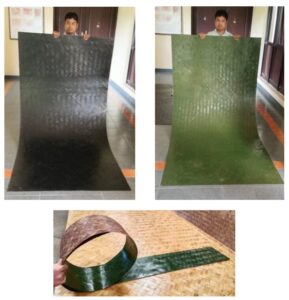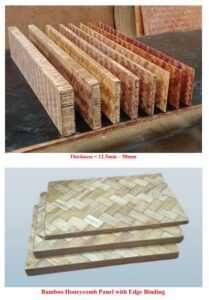Meditation and yoga have been integral parts of holistic wellness for centuries, promoting physical, mental, and spiritual well-being. Incorporating natural elements into these practices enhances their benefits, and one such powerful natural element is bamboo. Known for its strength, flexibility, and serene presence, bamboo has been deeply connected to meditation and yoga traditions across cultures. From bamboo mats and musical instruments to its symbolic representation of balance and peace, let’s explore how bamboo plays a vital role in meditation and yoga practices.
1. The Symbolism of Bamboo in Meditation and Yoga
Bamboo holds deep spiritual significance and aligns with key principles of meditation and yoga:
Resilience and Flexibility: Bamboo bends with the wind but does not break, symbolizing adaptability and inner strength in yoga and meditation.
Simplicity and Minimalism: A core philosophy in both yoga and mindfulness is minimalism, and bamboo embodies this through its unpretentious yet essential presence.
Growth and Renewal: Just like personal growth in meditation and yoga, bamboo grows steadily, representing self-improvement and spiritual enlightenment.
Balance and Harmony: Bamboo’s hollow structure reflects the importance of emptiness and receptivity, essential qualities for deep meditation and inner peace.
2. Bamboo as a Meditation Space Enhancer
Creating an environment conducive to meditation is essential for achieving deeper states of relaxation and mindfulness. Bamboo is a key element in designing such spaces:
Bamboo Meditation Rooms or Corners: Placing bamboo plants in meditation rooms purifies the air, brings tranquility, and adds to the Zen aesthetic.
Bamboo Water Features: The sound of water trickling through bamboo fountains has a soothing effect, helping to reduce stress and enhance concentration.
Bamboo Wind Chimes: The soft, rhythmic sounds of bamboo chimes promote relaxation, guiding the mind into a meditative state.
Bamboo Screens and Partitions: Using bamboo screens to create a secluded meditation space fosters a sense of privacy and deep focus.
3. Bamboo Yoga Mats and Accessories
Bamboo-based yoga accessories are gaining popularity for their eco-friendliness and durability. Some of the best bamboo yoga products include:
Bamboo Yoga Mats: Made from bamboo fibers, these mats provide a firm, non-slip surface and are biodegradable, making them an excellent alternative to synthetic mats.
Bamboo Yoga Blocks: These lightweight yet sturdy blocks offer support and stability in various yoga poses.
Bamboo Meditation Stools: For those who struggle with sitting cross-legged, bamboo meditation stools provide ergonomic seating, improving posture and comfort.
Bamboo-Infused Clothing: Breathable and antibacterial, bamboo fabric yoga wear keeps the body cool and comfortable during practice.
4. The Role of Bamboo in Sound Healing & Meditation Music
Bamboo has been used for centuries to create musical instruments that aid in deep meditation and relaxation:
Bamboo Flutes: Producing soft, melodious tunes, bamboo flutes have been used in spiritual and meditative practices in India, China, and Japan.
Bamboo Wind Pipes: The resonating sound of bamboo wind instruments helps deepen focus during meditation.
Bamboo Percussion Instruments: These instruments generate grounding vibrations that facilitate stress relief and mental clarity.
5. Bamboo in Breathwork and Pranayama Practices
Breath control is a crucial aspect of yoga and meditation. Bamboo can support breath-focused practices in various ways:
Bamboo Straws for Controlled Breathing: Practitioners use bamboo straws to regulate breath flow and enhance lung capacity during pranayama exercises.
Bamboo Incense for Deep Breathing: Burning bamboo-based incense, like sandalwood-infused bamboo sticks, creates an aromatic ambiance that enhances focus and relaxation.
6. Bamboo Forest Meditation: A Natural Therapy
Spending time in a bamboo forest can be an immersive meditation experience, also known as ‘Bamboo Forest Therapy.’ The natural setting of towering bamboo stalks offers several benefits:
Visual Relaxation: The lush green of bamboo forests reduces eye strain and calms the mind.
Sound Therapy: The rustling of bamboo leaves creates a natural white noise that aids in mindfulness.
Air Purification: Bamboo releases oxygen and absorbs toxins, providing a fresh, clean environment for deep breathing exercises.
Spiritual Connection: Many Buddhist monasteries and Zen gardens incorporate bamboo forests for deeper spiritual retreats.
7. How to Integrate Bamboo into Daily Meditation & Yoga
If you want to incorporate bamboo into your mindfulness routine, here are some simple ways to do so:
Practice yoga on a bamboo mat for a natural, grounded experience.
Meditate in a space with bamboo plants to enhance tranquility.
Use bamboo incense or essential oils to set the mood for deep relaxation.
Listen to bamboo flute music while meditating to elevate your experience.
Take a walk in a bamboo grove or garden to connect with nature before or after yoga practice.
Conclusion
Bamboo is more than just a plant—it is a powerful element that enhances meditation and yoga practices. Its presence fosters peace, resilience, and harmony, making it an ideal companion for spiritual and wellness journeys. By incorporating bamboo into meditation spaces, yoga sessions, and mindful breathing exercises, practitioners can deepen their connection with nature and experience a more profound sense of balance and relaxation. Whether through its symbolism, physical presence, or natural accessories, bamboo continues to play a crucial role in creating a holistic and healing yoga and meditation practice.





